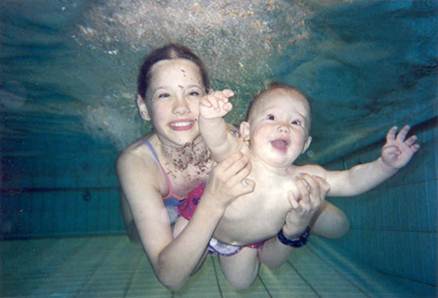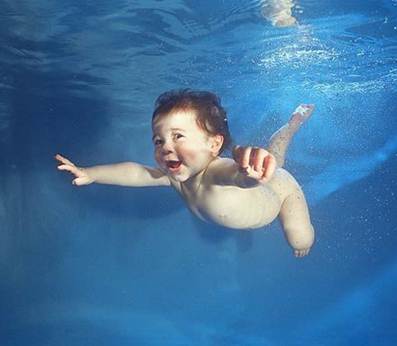You can teach your baby to swim when he/she reaches
6 months old.
Swimming is a necessary skill for life,
whether your baby likes it or not. You can teach your baby how to swim when
he/she reaches 6 months old.
There’re kids born to learn swimming
quickly though there’re some who are really afraid of water. Let’s take a look
at consultancy and experience from experts to get your baby more comfortable as
well as able to learn to swimming easier.
Start soon
You can also join swimming classes with
your baby when he/she gets over 6 months old. Through these classes, you will
learn a lot of things (how to form swimming movements, how to hold your baby
correctly…), which helps your baby to understand that the water is harmless to feel
more enthusiastic in learning to swim.

You
totally can teach your baby how to swim when he/she gets 6 months old.
In case there’s a pool in your house, you
have to hedge this area carefully with fences to prevent your baby from danger.
You also should invent rules of playing in yard in pool to enhance home people’s
responsibilities. For example, kids have to be accompanied when playing in the
yard.
Play under water
Before the baby gets old enough to swim, you
can play with him/her in bath tub to acquaint your baby with the water. Show
you baby how to splash though you may work harder to clean up everything later but
this makes him/her fonder of water.
During growth, babies learn skills and
knowledge via different ways in different speeds. You should try getting
him/her to learn to swim in early ages and monitor your baby’s process. And, of
course, learning time is limited under 30 minutes (for under-3-year-old kids)
and 45 minutes (for older kids).
Slow but sure
Not all of people like water. For baby that
is unacquainted with and scared of water, you can carry and gradually put
him/her into the water to make your baby feel safe and comfortable. Just smile
and talk to your baby that swimming pool was interesting, not threatening. The
more interested your baby gets in water, the more learning gets easier.
If your baby insists on not getting into
water, you shouldn’t force him/her to. Instead, lure the baby with his/her favorite
toys. Put the toy near shallow areas or steps to let your baby play and get
along with the water.
When your baby feels comfortable being in the
pool, you can start luring him/her into other areas.

When
your baby feels comfortable being in the pool, you can start luring him/her
into other areas.
Relax with water
Once the baby gets acquainted with the
water, try leaving him/her afloat to relax. Put the baby’s head on your
shoulder and keep him/her afloat. Promise that you won’t lose your hand and let
him/her float until the baby gets bored.
It’s difficult for a baby, when learning to
swim, to soak his/her face. Splash some water into his/her face to make the
baby acquainted. If he/she laugh, you can let your baby splash his/her face and
hair wet, like a playing a game.
Experts say that you shouldn’t take shortcuts
by dipping your baby right into the water. Teach him/her how to swim by tell
your baby to incline head towards both sides and feel the water flowing into
ears. Then, teach your baby to soak face under water.
When the baby gets acquainted with being
under water, excite him/her with safe games to make swimming more interesting.
There’re a lot of games available. Let’s
start with a ball then develop your further ideas.
Start from feet
Teach your baby with lessons for feet. Let
the baby hold swimming belt and practice the feet.
Use your hands to hold your baby’s flank
and chest plus let him/her practicing stroke with hands. Though, you must show
him/her how to move in the right way. If your baby focuses much on hand’s moves,
remind him/her of doing feet’s moves.
After the baby is proficient in basic moves,
try letting him/her swim toward you. Start with short distance – within your
hand’s range – then lengthen the distance gradually. You also can hold small
swimming competitions in your home to encourage your baby to practice.
Any skill needs hard practices and swimming
is, too. You should always remind your baby of practicing swimming, give
compliment for his/her right moves as well as time when your baby gets farther
to let the baby know that there’s a great progress.
When the baby grows older, he/she will know
how to breathe longer under water and thanks to this, your baby can swim
farther and longer. Encourage the baby to try new skills such as diving and
picking stuff in the bottom…
You can also let your baby jump into the
pool then find way to get afloat. This is most right time for your baby to complete
skills. Besides, you must teach your baby how to keep breathing regularly even
when swimming and treading to prevent exhaustion.
Additionally, you must also pay attention
to your baby’s feeling when he/she first starts. The baby may want to be alone
because there’re a lot of people watching.
You should show the baby that swimming is
not only a sport but also an interesting activity. Let’s learn how to swim with
your baby to share more time with your family.